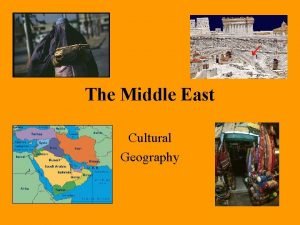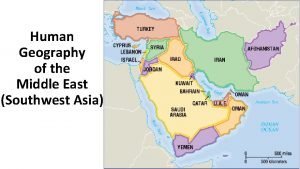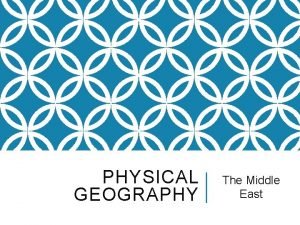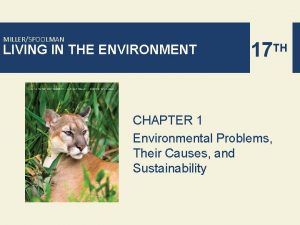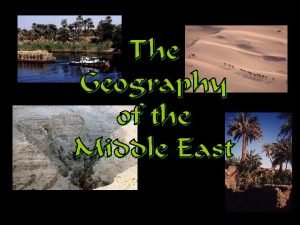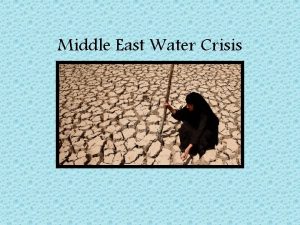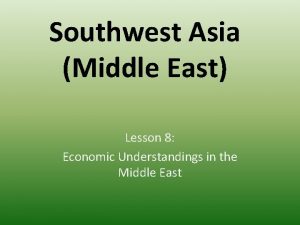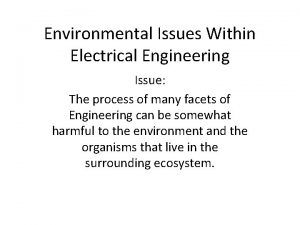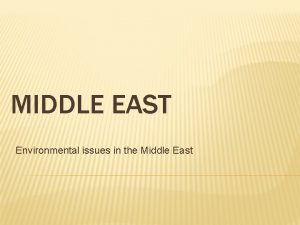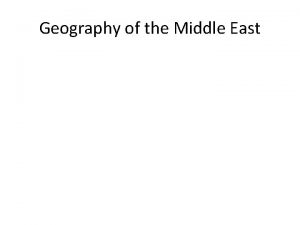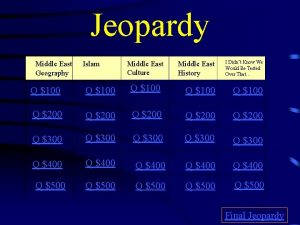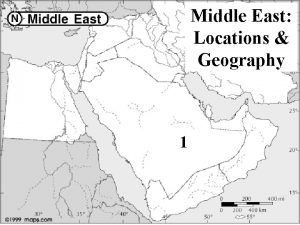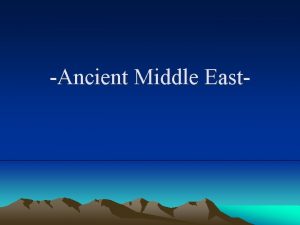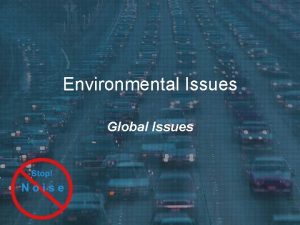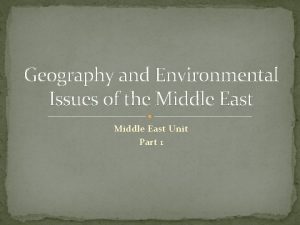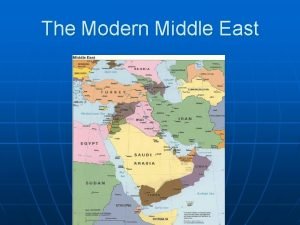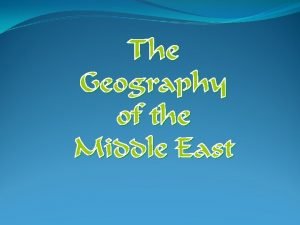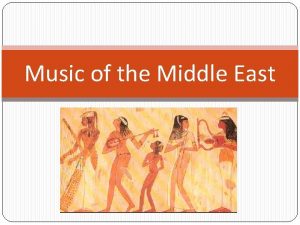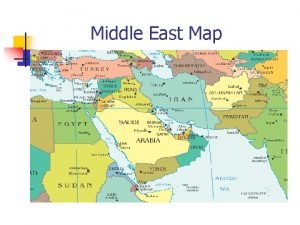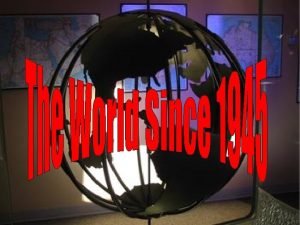Geography and Environmental Issues of the Middle East














- Slides: 14

Geography and Environmental Issues of the Middle East Unit Part 1

Georgia Performance Standards � SS 7 G 5 The student will locate selected features in Southwestern Asia (Middle East). � a. Locate on a world and regional political-physical map: Euphrates River, Jordan River, Tigris River, Suez Canal, Persian Gulf, Strait of Hormuz, Arabian Sea, Red Sea, and Gaza Strip. � b. Locate on a world and regional political-physical map the nations of Afghanistan, Iraq, Israel, Saudi Arabia, and Turkey. � SS 7 G 6 The student will discuss environmental issues across Southwest Asia (Middle East). � a. Explain how water pollution and the unequal distribution of water impacts irrigation and drinking water. � SS 7 G 7 The student will explain the impact of location, climate, physical characteristics, distribution of natural resources and population distribution on Southwest Asia (Middle East). � a. Explain how the distribution of oil has affected the development of Southwest Asia (Middle East). � b. Describe how the deserts and rivers of Southwest Asia (Middle East) have affected the population in terms of where people live, the type of work they do, and how they travel.

Political Map of the Southwest Asia

Physical Map of Southwest Asia

Make Up of the Middle East � The countries of Turkey, Iraq, Iran, Syria, Israel, Saudi Arabia, Lebanon, Jordan, Cyprus, Afghanistan, Bahrain, Qatar, U. A. E. , Oman, and Yemen make of the Middle East. � Afghanistan is a landlocked country which means it has no border that touches a seacoast. The country is also very mountainous. � Iran is one of the largest countries in the Middle East. This country is very mountainous but has a lot of access to many bodies of water for trade. � Iraq has two of the largest rivers in the Middle East running through it.

Countries of the Middle East � Saudi Arabia is the largest country in the Middle East and located on the Arabian Peninsula. � Turkey controls the source of the Euphrates and Tigris Rivers. � Israel is located along the coast of the Mediterranean Sea and has been in conflict with many of the countries in the region since it’s creation in 1948.

Major Landforms �Deserts are the most common landform of the Middle East. Deserts comprise nearly 66% of the region. �Gaza Strip and West Bank is disputed land between Israel and the Palestinians along the

Important Bodies of Water � Why is water so important to the Middle East? � The LACK OF WATER in the Middle East makes water one of the most important resources because the region is very dry. � The major rivers of the region are the Tigris River, Euphrates River, and the Jordan River. � Rivers are used for transportation, irrigation, hydroelectricity, trade, and many other needs. � Many of the major cities in the Middle East are located along bodies of waters.

Rivers � The source of the Tigris and Euphrates Rivers is found in the country of Turkey and ends in the Persian Gulf. Part of these rivers merge to form the border between Iran and Iraq. � The Jordan River is also part of the boundary of Jordan, Israel, Syria, and the West Bank. This river does not flow to the Red Sea but ends at the Dead Sea.

Other Important Bodies of Water �Suez Canal connects the Red Sea and the Mediterranean Sea. This makes travel for trade shorter because ships do not need to go around Africa. �Persian Gulf also known as the Arabian Gulf contains about 30% of the world’s oil. �Strait of Hormuz is the entrance and exit to the Persian Gulf. Much of the world’s oil passes through this strait. �The Dead Sea is where the Jordan River ends. Nothing can live in the Dead Sea because of it’s high salt content.

Climate � Desert/Arid- Hot and Dry and located in the desert lands. Much of the Middle East is covered in this climate. � Semi-Arid/Steppe- Hot and Dry with little rain and vegetation. This climate will be located along the borders of the desert. � Mediterranean- dry, sunny, warm summers and cooler winters with hardy vegetation and found along the coast of Northern Middle East.

Resources � The major resources of the Middle East are water, natural gas, and oil. � Water is important because of a lack of fresh water due to the lack of rain and surrounding bodies of salt water. � Oil and Natural Gas are important resources because it bring the region much wealth and the region controls over half of the world’s oil supply.

Water Problems of the Middle East � Water Distribution- the lack of water has caused water disputes/wars between countries that share rivers. Many countries will dam up rivers causing the flow to decrease down stream to the other countries. Also the hot climate and lack of fresh water due to overuse has caused water shortages. Due to the lack of water and the climate, many people will practice subsistence farming which means you grow only enough to feed your family. � Solutions: Desalination is the process of removing salt form sea water but is a very expensive process. � Solutions: Drip Irrigation is the process of using computers to measure out how much water a plant receives � Water Pollution has decreased the amounted of clean water to use for farming, drinking, and hygiene. � Water pollution has been caused the use of chemical fertilizers, industrial and human waste.

Oil Distribution �Oil is the most valuable resource in the region. �Oil is the primary source of income for most countries in the Middle East. �Saudi Arabia has the world’s largest oil and natural gas reserves.
 Kalahari desert on africa map
Kalahari desert on africa map Ethnic groups in the middle east
Ethnic groups in the middle east Human geography of middle east
Human geography of middle east Physical geography of middle east
Physical geography of middle east East is east and west is west
East is east and west is west Environmental and resource efficiency issues
Environmental and resource efficiency issues Environmental ethics issues and possible solutions
Environmental ethics issues and possible solutions West north west wind direction
West north west wind direction Middle east natural resources
Middle east natural resources Gope
Gope Lesson 1 latin america africa and the middle east
Lesson 1 latin america africa and the middle east Lesson 8 middle east and south asia
Lesson 8 middle east and south asia Nationalism in africa and the middle east
Nationalism in africa and the middle east Explain how dishes on a menu address environmental issues.
Explain how dishes on a menu address environmental issues. Electrical engineering environmental issues
Electrical engineering environmental issues

